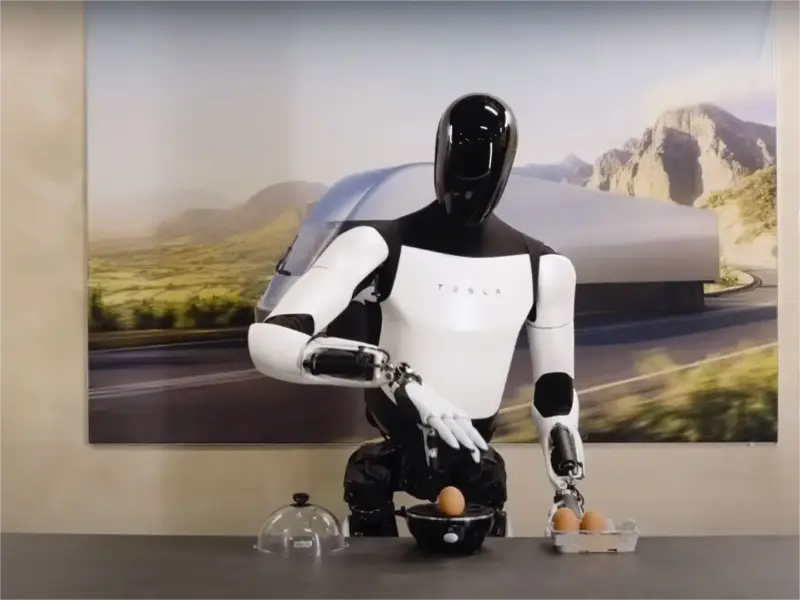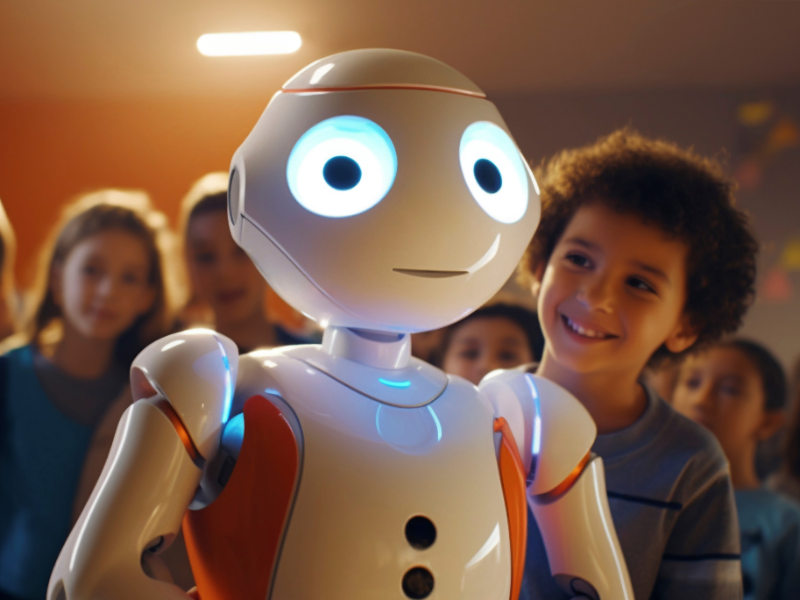- From basic cleaning tasks to advanced interaction and monitoring capabilities, home robots have evolved significantly over the last decade.
- Home bots are designed specifically for household tasks. They typically perform functions such as cleaning, cooking, and basic home maintenance. Example like Amazon’s Astro.
- Humanoid bots mimic human appearance and behaviors, often designed for more complex interactions. They can perform a broader range of tasks, including customer service, companionship, and even educational roles.
When considering domestic bots, the first that come to mind are cleaning robots and chatbots/smart speakers, which are currently the two most widely used home bots worldwide, according to the International Federation of Robotics report from 2022. Cleaning robots are widely accepted for their effectiveness in performing cleaning tasks, such as sweeping and mopping. Chatbots, like ChatGPT, which we are most familiar with on websites and mobile platforms, can answer our daily questions, such as how to cook our favorite dishes or what the largest river in the world is. Smart speakers, like TmallGenie and Amazon Alexa, are home chatbots that provide companionship by responding to immediate queries. I sometimes ask for a song to play as background music while I do things at home. Normally, this action would involve opening my laptop or phone, finding the music app, and clicking on the song to play it. The concepts of home cleaning bots and speakers are no longer new, but what about humanoid bots?
What is a humanoid bot? According to Wikipedia, a humanoid bot is a robot designed in the shape of a human body, primarily for functional purposes. To understand humanoid robots, we need to know the background of home bots first.
The evolution of home bots
Early Concepts (1950s-1970s): Initial designs focused on mechanical movement and basic functionalities, like ELIZA, a simple chatbot that mimicked conversation.
Increased Mobility (1980s-1990s): Robots like ASIMO by Honda showcased improved mobility and basic interaction capabilities, allowing them to walk and respond to simple commands.
Enhanced Interaction (2000s): Robots like Sony’s AIBO (a cute robot dog!) and Toyota’s Robina began incorporating emotional recognition and social interaction, making them more relatable to humans.
Advanced AI Integration (2010s): The introduction of sophisticated AI allowed robots like Sophia and Pepper to engage in meaningful conversations and understand human emotions, expanding their roles in social and customer service settings.
Current Developments: Humanoid robots are equipped with advanced sensors, machine learning, and robotics. They are able to perform complex tasks in various fields, from healthcare to entertainment. They are companions and helpers in daily life.
“Recent advances in AI and machine learning hold tremendous potential for advancing physical intelligence. The opportunity to implement TRI’s state-of-the-art AI technology on Boston Dynamics’ hardware is game-changing for each of our organizations as we work to amplify people and improve quality of life.”
Gill Pratt, chief scientist for Toyota and CEO of TRIAlso read: Sony’s Astro Bot DualSense controller goes up for pre-order
And, there are different kinds of home robot. Mainly categorized under home bots section.
Types of Home Bots
- Cleaning Robots: The most popular category, cleaning robots like the Roomba and Roborock have expanded beyond simple vacuuming. Many models now combine vacuuming and mopping capabilities, equipped with advanced navigation systems that allow them to learn the layout of a home, avoiding obstacles while optimizing cleaning paths.
- Security Robots: With the rise in demand for home security, robots equipped with cameras and sensors have become increasingly common. Devices like the Ring Video Doorbell and various smart surveillance cameras allow homeowners to monitor their properties in real-time, providing alerts for unusual activity and enhancing overall safety.
- Companion Robots: As society becomes more aware of the importance of mental health and companionship, robots designed for interaction have gained traction. Products like Joy for All offer emotional support and engagement, particularly for elderly individuals, serving not just as conversation partners but also as reminders for medication or appointments.
- Home Assistants: Devices such as Amazon Echo and Google Home serve as central hubs for smart home control. These voice-activated assistants manage various connected devices, provide information, and facilitate everyday tasks, from setting reminders to controlling lighting and temperature.

From the categories we see how home bots are specialized in four aspects in home application, now we’re going to understand humanoid bots, they are a more advanced, human appearance like robots that help with the home chores like some of the aspects above too, but definitely involves more in the interactions and companionship sections. Here is a quick question!
Pop quiz
What are four main aspects home bots provides?
A. Companionship, Monitoring, Security, Care
B. Smart Control, Cleaning, Interaction, Chat
C. Security, Cleaning, Companionship, Smart Control
D. Monitoring, Interaction, Cleaning, Security
Scroll down for Answer.
Humanoid bots are still quite a new term to the most. Examples like Tesla’s humanoid bot Optimus gen 2, which launched in 2024 June, and Figure 02 by OpenAI partnered with Figure AI, launched in 2024 August, followed by NEO Beta, launched at the end of August this year. Let’s dive into each of them.
Humanoid bots
Humanoid bots mimic human appearance and behaviors, often designed for more complex interactions. They can perform a broader range of tasks, including customer service, companionship, and even educational roles.
1. NEO Beta by 1X
NEO Beta is a humanoid robot developed by the robotics company Adept Technology (now part of Omron) and is part of their advanced robotics line. Its humanoid design enables it to engage users more comfortably, making it suitable for various applications across multiple sectors.
One of its standout features is its advanced mobility, allowing NEO Beta to walk, run, and navigate diverse environments with agility. This mobility is supported by sophisticated sensors and actuators that ensure safe navigation and adaptability to different terrains. The robot is also equipped with various sensors, including cameras and ultrasonic devices, enabling it to perceive its surroundings and interact intelligently with objects and people.
For communication, NEO Beta excels at verbal interaction. Its natural language processing enables it to understand voice commands and respond conversationally. AI algorithms facilitate machine learning, allowing NEO Beta to learn from experiences and improve responses over time. This adaptability enhances its ability to meet user needs effectively.
“Our priority is safety. Safety is the cornerstone that allows us to confidently introduce NEO Beta into homes, where it will gather essential feedback and demonstrate its capabilities in real-world settings. This year, we are deploying a limited number of NEO units in selected homes for research and development purposes. Doing so means we are taking another step toward achieving our mission.”
Bernt Børnich, CEO at 1X.In education, it serves as a dynamic teaching tool for robotics, coding, and STEM subjects. Students benefit from its engaging nature, fostering interest in technology and innovation. In healthcare, NEO Beta assists elderly patients, providing companionship and support in care facilities. This enhances the quality of life for individuals who may feel isolated.
In customer service, NEO Beta can greet customers and answer inquiries in retail and hospitality settings. Its friendly approach improves service quality and efficiency. Additionally, NEO Beta acts as a valuable platform for research and development in human-robot interaction and AI advancements.
2. Figure 02 by Figure.AI
FIGURE 02
Figure 02 is a humanoid robot developed by a leading robotics company Figure AI(partnered with OpenAI) with the primary goal of enhancing human-robot interactions. The company’s design aims to create a robot that seamlessly integrates into daily life, providing assistance and companionship. Its sleek, human-like appearance allows for natural, comfortable interaction, making it ideal for social environments such as homes, healthcare facilities, and educational settings.
The robot’s design focuses on both form and function. Equipped with advanced sensors, Figure 02 can recognize facial expressions and interpret emotional cues, fostering meaningful engagement with users. Its facial movements are controlled by actuators that allow it to express a range of emotions, making it effective in settings like elder care where emotional connection is crucial.
In terms of performance, Figure 02 excels across different areas. In healthcare, it supports patients by reminding them of medication schedules, providing companionship, and offering mobility assistance. Its speech recognition and natural language processing systems make communication smooth and intuitive, allowing users to give simple verbal commands or engage in more complex conversations.
In educational settings, Figure 02 acts as a tutor, adapting lessons to the student’s learning style. It can present interactive materials, answer questions, and monitor progress, making learning more dynamic. Additionally, its mobility and dexterity enable it to handle precise tasks in industrial environments, such as assembling components or transporting materials.
3. Tesla’s Optimus
Tesla’s Optimus bots represent a groundbreaking leap in robotics. These humanoid robots are designed to assist with various tasks. They can perform both physical and cognitive jobs, enhancing productivity in multiple environments. Equipped with advanced AI, Optimus bots learn and adapt quickly. They can navigate complex settings, understanding their surroundings in real time. This capability allows them to work safely alongside humans. The bots are built to handle repetitive tasks efficiently. They excel in manufacturing, logistics, and even domestic chores. With their dexterity and strength, they take on labor-intensive activities that often burden workers.
Tesla aims to make these bots affordable for everyday use. This approach ensures that more people can benefit from robotic assistance. As production scales, Tesla envisions Optimus bots in homes and businesses globally. Each robot features a sleek design, embodying Tesla’s innovative spirit. The integration of cutting-edge sensors and cameras enhances their functionality. This technology enables the bots to perform tasks with precision and care. The development of Optimus aligns with Tesla’s broader vision. The company seeks to revolutionize transportation and energy while improving daily life. Optimus bots serve as a crucial element in this transformative journey.
 OPTIMUS
OPTIMUS| Feature | NEO Beta | Figure 02 | Optimus |
| OPITICAL SENSORS | 2 cameras | 6 RGB cameras | 4 cameras |
| BATTERY | 2.3 KWh | 2.25 KWh + 50% runtime | 50 KWh |
| HANDS DoF | 20 | 16 | 11(22 planned) |
| COMPUTE | Nvidia Jetson Thor | 3x compute onboard AI interference | Tesla hardware 4 |
| SPEECH RECOGNITION | ✔︎ | ✔︎ | ✔︎ |
| WEIGHT | 30kg | 70kg | 73kg |
| HEIGHT | 5’5″ | 5’6″ | 5’8″ |
| WALKING SPEED | 7.5 mph(pace 2.5mph) | 1.2m/s | 1.3 mph(est.) |
| PAYLOAD | 19.96kg | 20kg | 20.4kg |
| PRICE | not available | around $20,000 | between $20,000 and $30,000 |
Also read: MIT unveils a new way to simulate training for home robots
Future trends of home bots
First, enhanced AI will enable bots to better understand natural language, behavior, and routines, allowing for seamless integration into daily life. Voice and facial recognition technology will also improve, making bots more intuitive and capable of recognizing individual family members’ needs. In the future, bots may adapt their responses to users’ moods, predict their needs, and perform tasks without direct instructions.

First, enhanced AI will enable bots to better understand natural language, behavior, and routines, allowing for seamless integration into daily life. Voice and facial recognition technology will also improve, making bots more intuitive and capable of recognizing individual family members’ needs. In the future, bots may adapt their responses to users’ moods, predict their needs, and perform tasks without direct instructions.
Another trend is the shift towards multi-functionality. Unlike early single-purpose bots, future home bots will handle various tasks, from vacuuming and cooking to scheduling and home security. These bots will be able to connect with other devices in the smart home ecosystem, creating a centralized system that learns and manages the entire household efficiently. With IoT and 5G technologies, bots will interact in real-time with other smart devices, creating a synchronized home environment.
Additionally, there will be a strong focus on emotional intelligence in bots designed for companionship, particularly for elderly and disabled users. These bots will act as social partners, capable of conversation, reminders for medication, and even health monitoring. Over time, this can promote mental well-being and help reduce loneliness for those living alone.
Finally, as bots become more commonplace, customization will rise in importance. Future models may allow users to personalize appearance, voices, and functionality to align with personal needs and lifestyles. Together, these trends point towards a future where home bots are not only efficient helpers but also trusted companions and essential components of the smart home experience.
The answer of pop quiz is option C.




















 English (US) ·
English (US) ·